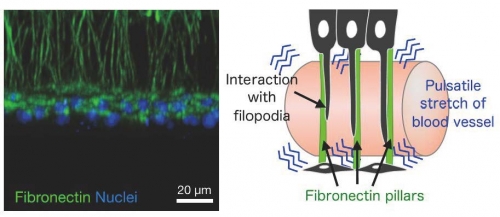研究成果 Research Results
- TOP
- News
- Research Results
- Architectural pillar-like distribution of extracellular matrix
Architectural pillar-like distribution of extracellular matrix
2017.01.25Research ResultsLife & Health
Within living tissue, cells may exchange information with other cells and tissues by exerting forces on the extra-cellular matrix (ECM). Fibronectin (FN) is an important ECM component that forms fibrils through cell contacts and creates directionally biased geometry. We found that the extracellular gap between widely separated tissues is spanned by pillar-like arrangements of FN fibrils. In striking contrast to previously reported patterns of FN distribution near the basal surfaces of cells, we found that the FN pillars extend far away from cell bodies into the gap space. Alongside the FN pillars, long filopodia protrude from the basal surface of cells. Inhibition of the filopodia formation abolished the FN pillars, indicating that FN pillar formation is dependent on the filopodia. We also identified a new mechanism contributing FN pillar formation by focusing on cyclic expansion of adjacent blood vessel. Maintenance of the directional alignment of the FN pillars depends on pulsatile flow through the blood vessels. These results suggest that the FN pillars are specifically established through the filopodia-mediated and mechanical force-related mechanisms.

Many long FN fibrils (green) are patterned as pillars (left panel). These FN pillars are formed through interaction with filopodia and pulsatile mechanical stress generated by adjacent blood vessel (right panel).
Journal Reference
Basal filopodia and vascular mechanical stress organize fibronectin into pillars bridging the mesoderm-endoderm gap, ,Development, 10.1242/dev.141259Research-related inquiries
- TOP
- News
- Research Results
- Architectural pillar-like distribution of extracellular matrix































